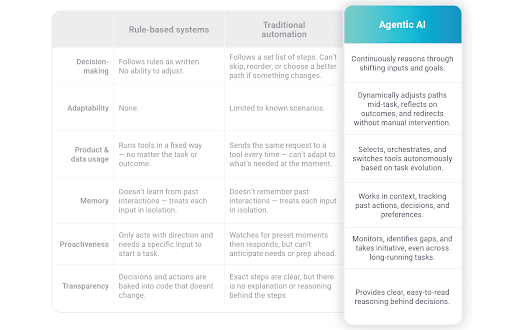- Not all agentic AI is created equal. Knowing how to spot the difference between true agentic and false agents will save you time and money.
- Adoption of AI, including agentic, is rising fast and fueling major economic growth, contributing $15.7T to the global economy by 2030 according to PwC.
- Recruiting teams using agents will be poised to gain speed, scale, and strategy.
You’ve seen it before: a new wave of AI tools that promise to “streamline this” and “automate that” without increasing head count. While it all sounds appealing, it often results in minor adjustments to existing automation, making it run faster rather than offering real innovation.
However, the HR tech stack landscape is shifting with the introduction of agentic AI.
While many tech providers might be making big promises around what their agentic AI can do, there are real differences between the capabilities of true agentic vs. false agents. True agentic AI enhances automation by connecting processes to data across various platforms. It goes beyond simply improving efficiency; it involves taking action on that work, automating multi-step processes, and gathering deeper insights to inform and improve how it works.
In recruiting, agentic AI can assist your TA teams by autonomously handling tasks like candidate sourcing, customizing outreach, managing workflows, and even making decisions on your behalf.
This marks a significant shift in recruiting — but are the promises of agentic AI merely hype or truly game-changing?
Here, we’ll explore the essence of true agentic AI, explain why AI is poised to have a substantial impact on the global economy, and discuss how these agents are already influencing the recruitment process.
Related content: Learn how agentic AI can fast-track hiring by automating multiple tasks simultaneously to kick off new role searches efficiently.
Spotting true agentic AI vs. fake agents
If agentic AI hasn’t hit your radar yet, get ready. You’re sure to see it everywhere soon. There’s an influx of products entering the market labeled as “agents,” but not all agents are created equal. It’s essential to understand the difference from the start.
True agentic AI mirrors the nuances of our daily cognitive work — things like switching contexts on the fly, connecting seemingly unrelated dots, or adapting plans to new information received in real time.
Source: Agentic AI in HR
False agents may seem to accomplish these tasks, but these are essentially a scripted system that follows rigid, predefined steps, and single-shot prompts. There is no real understanding of nuance or flexibility.
Why is it important to spot the differences? Your talent team is juggling complex and high-volume tasks. The goal of using agentic AI as a teammate in HR is to run workflows, adapt to changes, and apply human-like judgment across all the moving pieces in recruiting to improve productivity and efficiency.
True agentic AI expands your team’s thinking powers, lifts a manual and mental weight off your team by spotting issues, and gives them more space to focus on strategy. Opting for a false agent can escalate costs from inefficiencies in systems needing constant oversight, create security and compliance gaps, and cost your trust in systems that overpromise and underdeliver.
Related content: How can agentic AI change your organization? See how Eightfold Agentic AI is fast-tracking hiring, helping source best-fit talent, automating routine recruiting tasks, and more.
Agentic AI’s impact on the economy
The use of AI is growing dramatically quarter to quarter, and it’s having a significant impact on economies around the world. Deloitte predicts that before the end of the calendar year, 25% of organizations already using AI for productivity gains will launch agent pilots or proofs of concept. They anticipate that the percentage will double by 2027.
An AI quarterly pulse survey from KPMG puts these numbers at an even higher rate for the first quarter of 2025: 65% of organizations surveyed said they are piloting agents, up from 37% in Q4 of 2024. And nearly all of them (99%) say they plan to deploy agents via pre-built solutions or a combination of pre-build and purchased solutions this year.
KPMG’s survey also shows a 28% growth in AI investments from Q4 of 2024 to Q1 of 2025 — up to $114 million from $89 million.
“We’re seeing a clear shift from pilots to scaled execution, with CIOs increasingly leading the charge,” Steve Chase, Vice Chair of AI and Digital Innovation at KPMG, LLP, said in the survey. “Leading organizations are creating space — often through a dedicated AI leader — to fully own that broader vision and protect the transformation from unnecessary risk.”
This data shows that organizations already incorporating AI into their workflows are growing in numbers and are not slowing down. They’ll continue to move quickly to adopt tech advances in AI.
Why does all this matter? According to PwC, AI could generate up to $15.7 trillion in the global economy by 2030. The future of gen AI is agentic, making agents a powerful asset in your HR tech stack.
Agentic AI is ready to enhance recruiting
In action, the goal of agentic AI is not to replace workers but to automate up to 80% of your workload, according to our estimates. Ideally, this frees up time for higher-value tasks in recruiting, like complex decision-making and final candidate selection.
One task agentic AI could take off your recruiter’s plate is manually screening and interviewing candidates.
“While getting to know candidates is important, spending a lot of your time at the beginning stages of the screening process can be counterproductive,” Vineet Abraham, former Chief Development Officer at Eightfold AI, writes in this blog post. “Interviewing too many similar candidates can be time-consuming and actually limit your ability to focus on more strategic thinking in hiring decisions.”
| Metric | Before agentic AI | With agentic AI |
| Time to hire | 65+ days | 10x faster |
| Recruiter workload | 25% spent on screening | Significantly reduced |
| HR operational costs | High due to manual work | Lowered by automation |
| Hiring decision accuracy | Based on résumés and interviews | Data-driven, skill-based hiring |
An agent’s ability to understand nuance in those interviews is also a benefit. While AI has struggled with adaptability, agents improve this area and allow for real-time assessments and responses.
The third area where agentic AI is already impacting recruitment is allowing for better evaluations of candidate quality. This can be done through interview quality, real-time adaptability, and response evaluation.
“There will still be a need for you to step into the recruiting process at the right time to validate AI-generated scores and help refine the evaluation process,” Abraham continued.
Additional benefits of using agentic AI in recruiting include:
- Bias reduction: Standardizes evaluations to minimize human bias.
- Improved quality: AI objectively assesses technical skills.
- Scalability: Screens thousands of applicants fairly and efficiently.
- Consistency: Ensures every candidate receives a structured evaluation.
“Agentic AI represents the next evolution in recruitment,” Abraham writes. “Those who embrace working with AI agents early on will have an advantage in attracting and hiring in a world where top talent is increasingly hard to find.”
High-volume hiring: where hype meets reality
If there’s any area that proves agentic AI isn’t just hype, it’s high-volume hiring. Traditional recruiting methods crumble under the pressure of hundreds or thousands of applications for warehouse, retail, or health care roles. Recruiters can’t keep up, hiring managers are frustrated, and good candidates slip away when the process drags on.
Agentic AI changes this dynamic by doing what humans simply can’t at scale: interviewing every single applicant, instantly and consistently. Candidates move straight from application to interview, 24/7, with structured conversations that deliver actionable insights to recruiters.
Instead of rationing time and making rushed decisions, talent teams get complete, high-quality data on the entire applicant pool. The result is faster hiring, stronger candidate experiences, and better workforce outcomes.
For organizations battling constant frontline staffing shortages, this isn’t about shiny technology. It’s about solving a problem that’s been broken for decades.
Agentic AI: All hype or a game-changer?
While the term agentic AI may be new to the talent space, its impact is already very real. Unlike traditional automation tools that accelerate repetitive tasks, agentic AI introduces autonomy, adaptability, and decision-making into the recruiting process.
It’s not just about working faster — it’s about working smarter with technology that acts more like a teammate than a tool.
The organizations already investing in agents aren’t just experimenting. They’re scaling. As the data shows, adoption is accelerating, and for good reason: the potential to reduce bias, improve candidate quality, scale hiring efficiently, and free up your recruiters to focus on strategy isn’t just attractive — it’s transformative.
So, is agentic AI a game-changer in recruiting? Absolutely. The challenge ahead isn’t whether to adopt it but how quickly teams can embrace the shift, build trust in the tools, and reimagine the roles they play alongside them.
Ready to embrace the shift with your team? Learn more in our Agentic AI in HR guide.

